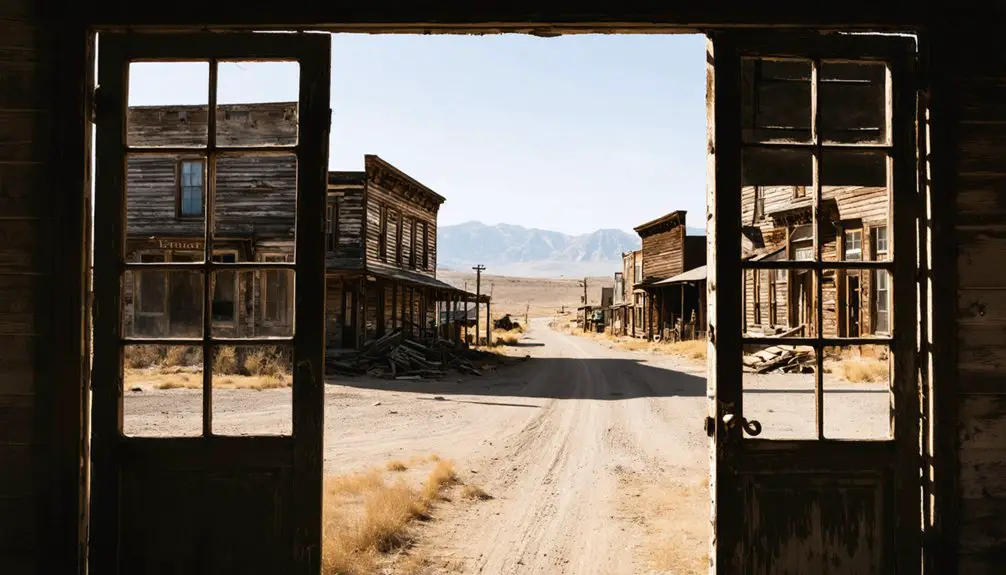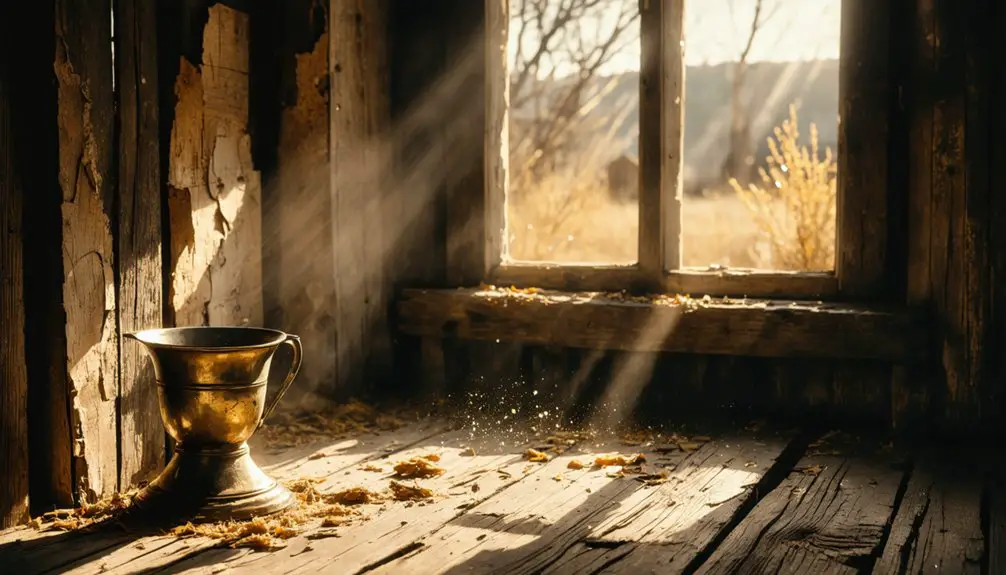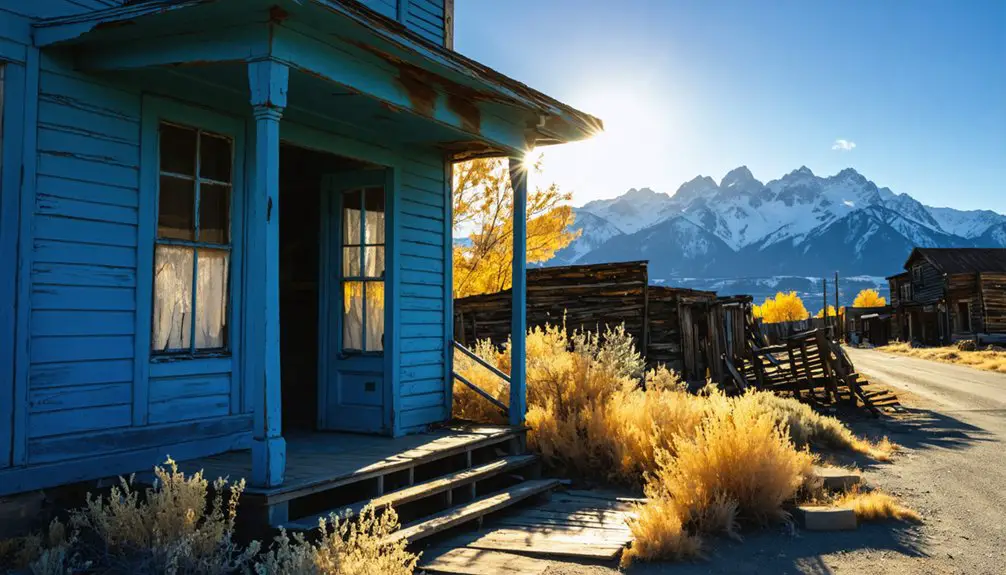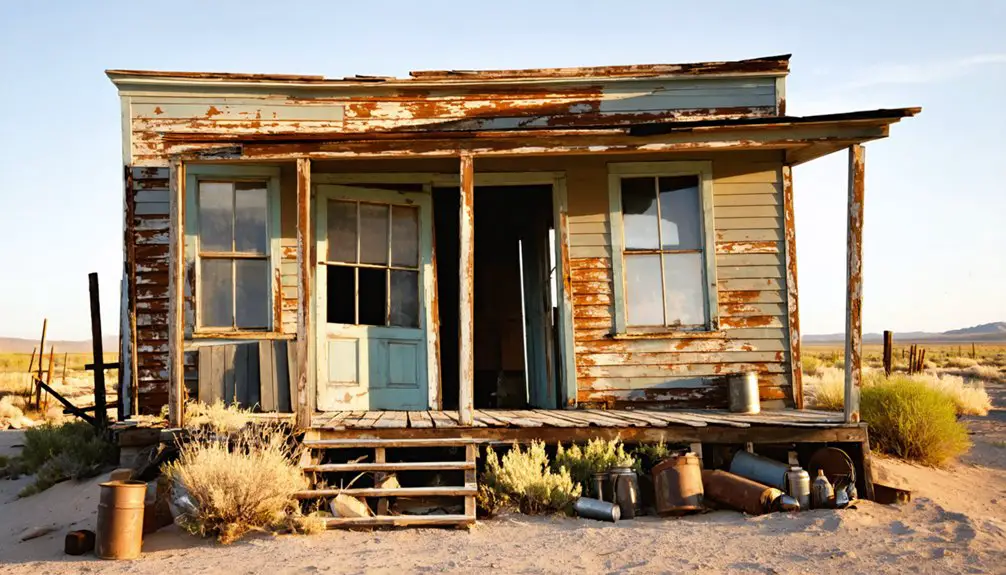You’ll find Bodie, Washington’s historic gold mining town nestled in Ferry County, where prospector Henry Dewitz struck gold in 1890, leading to a significant $80,000 discovery. Unlike its violent California namesake, this peaceful mining settlement flourished until 1934, producing $1.2 million in gold through innovative processing methods and round-the-clock operations. Today, a single original structure stands among the ruins, offering glimpses into Washington’s rich mining heritage.
Key Takeaways
- Bodie, Washington was established in 1888 when Henry Dewitz discovered gold, yielding $80,000 from a single ore pocket.
- The site contains only one remaining original structure, distinguishing it from the more preserved Bodie ghost town in California.
- Mining operations produced approximately $1.2 million in gold by the early 20th century, with ore shipments valued at $500 per ton.
- The Wrigley family built a steam-powered mill in 1902, later modernized to process 70 tons of ore daily.
- Mining activity ceased permanently in 1942 due to the War Production Board order L-208, turning Bodie into a ghost town.
A Tale of Two Bodies: Separating Fact From Fiction
A persistent source of confusion surrounds Bodie, Washington’s ghost town, which is frequently mistaken for its more famous California namesake or the original Montana site.
You’ll find that these Bodie misconceptions run deep, particularly regarding the structures and their purposes. While California’s “Big Bad Bodie” earned notoriety for violence, Washington’s site maintained a more peaceful reputation focused on mining operations. Proper internal link navigation helps visitors distinguish between these historically significant locations.
Mining myths have blurred the lines between these locations, with local oral histories disputing the identity of the largest standing structure, often incorrectly labeled as a schoolhouse or saloon. At an elevation of 8000 feet, California’s Bodie stands as a testament to the harsh conditions gold rush settlers endured.
The sawmill operations near Toroda Creek have added to this confusion. Unlike its California counterpart with numerous preserved buildings, Washington’s Old Bodie retains just one intact structure, making it distinct from other ghost towns bearing the same name.
The Birth of a Mining Boomtown
While prospectors first discovered gold in the Bodie Mining District in 1859, the camp remained relatively quiet with scattered placer mining until 1875, when a cave-in at the Bunker Hill mine revealed a rich ore vein.
You’ll find that this discovery sparked the Standard Company’s large-scale operations in 1877, leading to industrial mining with a 20-stamp mill and consistent bullion production exceeding $784,000 that year alone. The mill later transitioned to electric power after being rebuilt from a fire in 1898.
The transformation from a small mining camp to a bustling boomtown happened remarkably fast, as Bodie’s population surged from just a few dozen residents to between 7,000 and 10,000 people by 1880. The rapid growth led to the construction of 2,000 buildings by 1879.
Early Gold Strike Discovery
The remarkable gold strike that birthed Bodie, Washington began in 1890 when prospector Henry Dewitz discovered rich mineralized outcrops near Bodie Creek.
His prospecting adventures led him to establish a settlement in 1888, but it wasn’t until he struck a significant lode about a mile north that Bodie’s destiny changed forever. This pivotal gold discovery yielded an astounding $80,000 from a single pocket of ore. The thriving community quickly grew to include a general store and other essential businesses. Like its California namesake, the town reached peak population during the height of its mining operations.
The geological formation where Dewitz made his find consisted of gold-bearing quartz-calcite veins embedded in volcanic tuff and andesine rock.
These veins, averaging four feet in width, contained free gold and pyrite, similar to the renowned deposits found in the Republic district.
This initial strike would set the stage for decades of mining operations that followed.
Mining Camp Takes Shape
From humble beginnings in 1888, Bodie’s transformation into a bustling mining camp began with the construction of essential log buildings at Bodie Creek’s mouth. Historical records emphasize the importance of reliable documentation in understanding the town’s true development.
You’d find the early settlement quickly expanding with crucial services – a restaurant, general store, smithy shop, and livery barn by 1896. The community’s infrastructure grew to support both permanent residents and transient miners seeking their fortune.
The Wrigley Brothers’ arrival in 1902 marked a significant advancement in mining techniques with their steam-powered reduction mill, revolutionizing ore processing capabilities. The operation thrived until World War II forced the mine’s closure in 1941.
Community dynamics centered around social hubs like the Bodie Hotel, which served as accommodation for newcomers and workers. The boomtown atmosphere fostered lasting development, establishing foundations that would support decades of mining operations and shape the distinctive character still visible in today’s ghost town remains.
Rapid Population Growth
Following precious mineral discoveries in northern Okanogan during 1886, Bodie’s population surged as prospectors and settlers flocked to the promising mining district.
The population dynamics shifted dramatically as mining operations expanded, with up to 40 miners working around the clock in three shifts during peak production periods of the 1930s.
The workforce influx led to rapid development of essential infrastructure, including a restaurant, general store, smithy, and numerous log cabins to house the growing community.
You’d have witnessed the town’s transformation as the Wrigley family’s investment in 1902 brought steam-powered operations and increased production capacity.
Golden Years: Mining Operations and Economic Growth
You’ll notice that Bodie’s early mining infrastructure, initially powered by steam engines and stamp mills, underwent significant technological evolution with the introduction of hydroelectric power in 1893.
The district reached peak production between 1888-1917, with the Standard Company leading operations and producing over $18 million in gold and silver during its lifetime. The Bodie Railway & Lumber provided essential wood supplies to support these extensive mining operations. The Standard Company emerged from the original Bunker Hill Mine after being purchased for $67,500 by San Francisco investors.
The mill operations became increasingly sophisticated through advancements like the 1890 cyanide process, which allowed miners to extract precious metals from previously unprofitable low-grade ores and mill tailings.
Early Mining Infrastructure Development
As Bodie’s mining operations expanded in the 1860s and 1870s, the district rapidly developed sophisticated infrastructure to support its burgeoning industry.
You’ll find that by 1881, the district operated 30 active mines and 9 stamp mills, featuring 159 rock-crushing stamps that showcased the era’s advanced ore processing capabilities.
To overcome infrastructure challenges and timber scarcity, the district established the Bodie Railway & Lumber Company in 1881.
You’d have seen this narrow-gauge railway transporting essential cordwood and timbers from forests south of Mono Lake, enabling deeper mining operations.
Steam-powered pumps were installed in 14 mines, requiring substantial timber supplies to extend shafts below the water table.
Despite these innovations, many promising mines were abandoned within years, highlighting the volatile nature of early mining ventures.
Peak Production Years 1888-1917
When the Bodie Mine entered its golden age in 1888, production soared to unprecedented levels under a succession of ambitious owners.
By 1916, the mine had yielded approximately $130,000 in gold at $20.67 per ounce, with total recoveries reaching $1.2 million by the early 20th century.
The economic impact of Bodie Mine was remarkable during this period, with ore shipments commanding $500 per ton at smelters as far as Canada.
You’d find up to 40 miners working round-the-clock shifts across multiple claims, including Bodie, Bodie #2, West Cliff, Crystal Bluff, and Little George.
The Wrigley family’s ownership from 1902 to 1911 brought significant modernization through steam-powered milling, while subsequent operators like Bodie Mining and Transportation Co. maintained the mine’s profitability until 1916.
Mill Operations and Processing
The Bodie Mine’s milling operations underwent significant technological evolution during its golden years, beginning with the Wrigley family’s construction of a steam-powered mill in 1902.
Gold extraction methods evolved from mercury amalgamation to straight-leach cyanidation, while milling techniques improved to process up to 70 tons of ore daily by the mid-1930s.
- Early ore contained exceptional grades, sometimes yielding up to 20 ounces of gold per ton
- Northern Gold Company’s 1935 mill rebuild modernized processing capabilities
- Operations ran continuously with three shifts of workers processing ore
- The mill processed 66,032 tons between 1940-44, averaging $10 per ton in gold
The mill’s efficiency peaked under Northern Gold Company’s management, employing 40 workers and processing ore continuously until the 1941 government-mandated shutdown under Order L-208.
Life in the Wild West: Social Scene and Daily Activities
Life in Bodie revolved around a vibrant yet notoriously dangerous social scene, where 65 saloons served as the epicenter of daily entertainment and community gathering.
These social hubs buzzed with gambling, drinking, and frequent gunfights, earning the town its reputation as a “sea of sin.” You’d find a vibrant nightlife pulsing through brothels, opium dens, and gambling halls, while Chinatown maintained its own cultural identity with boarding houses and a Taoist temple.
Beyond the chaos, you could join fellow residents at the baseball field or racetrack for moments of communal celebration.
Yet survival remained challenging – you’d face primitive living conditions, scarce resources, and the constant need to import food and supplies by mule or rail through the harsh high-desert environment.
Architecture and Town Layout Through Time

Against the backdrop of Bodie’s raucous social scene emerged a distinctly Western architectural landscape, shaped by the town’s explosive growth following an 1875 gold vein discovery.
From gold-rich earth rose Bodie’s wild frontier architecture, a testament to the explosive growth of this 1875 boomtown.
You’ll find a town that once boasted 2,000 structures housing up to 10,000 residents, with wood-frame buildings dominating the skyline. The layout followed a rough grid pattern, adapting to the mountainous terrain while maintaining architectural authenticity through functional design.
- Original structures included the Miners’ Union Hall, hotels, saloons, and a bank with its distinctive brick vault.
- Two devastating fires in 1892 and 1932 destroyed 90% of the town’s buildings.
- The remaining structures are preserved in “arrested decay,” maintaining their historic preservation status.
- Green Street showcases residential architecture, now home to the ranger station.
Notable Characters and Historical Events
Mining pioneers Tommy Ryan and Phil Creasor sparked Bodie’s remarkable history in 1886 when they discovered valuable mineral deposits that would transform this remote Washington territory.
Among the mining legends who followed, Henry Dewitz established the settlement in 1888, striking the major lode that would become the Bodie Mine. The Dewitz brothers later sold to the Wrigley Brothers, who revolutionized operations by building a reduction mill in 1902.
The mine’s fortunes fluctuated with gold prices, yielding approximately $1.25 million before its final closure in 1944.
Historical preservation efforts continue through residents like Doug Prichard, who protected the last remaining original “Old Bodie” building.
While less notorious than its California namesake, you’ll find Bodie’s story reflects the quintessential boom-and-bust cycle of American frontier mining towns.
The Decline: From Boom to Abandonment

Although Bodie’s mining operations initially thrived with a peak production of $3.1 million in 1881, the town’s decline began taking shape that same year as prospectors departed for promising ventures in Montana, Butte, Tombstone, and Utah.
You’ll find that by 1914, mining profits plummeted to under $7,000, marking a severe economic downturn. The shift from a bustling mining hub to a ghost town was gradual but inevitable.
- The last printing of The Bodie Miner newspaper in 1912 signaled cultural decline
- Pockety ore deposits and falling gold prices led to mine closures by 1934
- A devastating fire in 1932 accelerated the town’s abandonment
- War Production Board order L-208 in 1942 permanently ended mining activities
What Remains: Modern Day Ghost Town
Today’s visitors to Bodie will find a haunting tableau of Washington’s mining history, with just one fully intact original structure remaining: a modest two-story house now used for storage.
Along Toroda Creek Road, you’ll discover numerous deteriorating bunkhouses, log cabins, and rusted mill remnants slowly being reclaimed by the lush northern forest.
Time stands still along Toroda Creek Road, where decaying mining structures surrender quietly to nature’s slow, steady advance.
While historical preservation efforts remain minimal, the site’s authentic mining camp atmosphere draws historians and photographers.
You can still spot traces of gold in the creek’s waters, a reminder of the $1.2 million in precious metal once extracted here.
Though access requires permission and ghostly encounters are frequently reported, Bodie’s uncommercialized state offers you a genuine glimpse into early 1900s mining life, free from tourist trappings.
Planning Your Visit to Bodie’s Ruins

When planning your expedition to Bodie’s ruins, meticulous preparation proves essential for a rewarding experience. Located 12 miles north of Wauconda in Okanogan County’s northeast corner, this historic site demands careful consideration for visitor safety and ghost town preservation.
You’ll find the site along the east banks of Toroda Creek, though winter conditions often impact accessibility.
- Always check current road conditions before departing, as snow closures are common during winter months.
- Bring adequate water supplies and wear sturdy footwear for traversing uneven terrain.
- Prepare for variable mountain weather conditions, including sudden changes in temperature.
- Respect posted signs and avoid entering unstable structures to support preservation efforts.
Pack appropriate gear and plan your visit during summer months for ideal access to the site’s historic remnants.
Frequently Asked Questions
What Happened to the Original Mine Equipment and Machinery?
You’ll find most equipment stayed put due to mind-blowing mine restoration efforts, though some got salvaged. Historical preservation challenges meant large machinery like stamp mills remained frozen in time as preserved artifacts.
Were There Any Documented Paranormal Activities in Bodie’s Ruins?
You won’t find documented ghost sightings or haunted locations in Bodie, Washington’s ruins. Historical records show no verified paranormal activity, though people often confuse it with California’s famously haunted Bodie.
How Did Residents Get Medical Care in Early Bodie?
You’d have relied on home remedies, traveling doctors, and community support since Bodie lacked medical facilities. For serious healthcare challenges, you’d face a difficult 15-mile journey to Wauconda’s limited services.
What Native American Tribes Lived in the Area Before Mining?
While you might think this area was uninhabited, Native tribes including the Okanogan, Methow, San Poil, Nespelem, Lakes, Colville, Calispel, Spokane, and Coeur d’Alene called this culturally significant region home.
Did Any Famous Outlaws or Gunfighters Ever Visit Bodie?
You won’t find documented outlaw sightings or confirmed gunfighter legends at either Bodie location. While Bodie, California had general lawlessness, there’s no evidence famous outlaws ever visited these mining towns.
References
- https://en.wikipedia.org/wiki/Bodie
- https://www.parks.ca.gov/?page_id=26330
- https://usghostadventures.com/haunted-places/bodie-ghost-town/
- https://www.trailchick.com/bodie-ghost-town/
- http://www.ghosttownsusa.com/bodie.htm
- https://kids.kiddle.co/Bodie
- https://hauntedhouses.com/california/bodie-ghost-town/
- https://www.pacificadventureclub.com/blog/the-infamous-bad-man-of-bodie-california-ghost-town-a-haunting-history
- http://www.bodiehistory.com/bodie.htm
- https://www.parks.ca.gov/bodie



